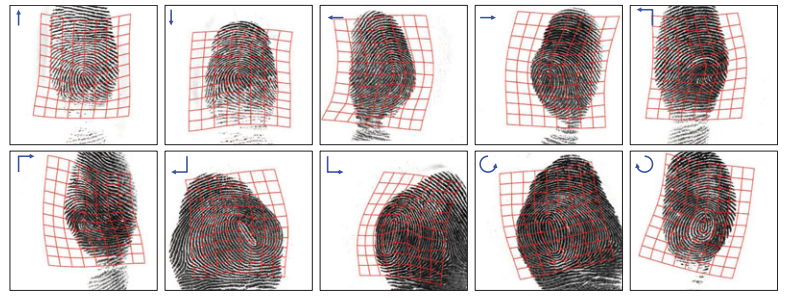Tsinghua Distorted Fingerprint Database

Data collection method
Fingerprints are collected using a Fourier transform infrared spectrum (FTIR) fingerprint scanner with video acquisition functions. To generate distorted fingerprints, a volunteer firstly restrains a fingerprint with a standard posture, and then purposely adds distortion and gradually increases the distortion. After that, the acquired fingerprints are transformed into a video sequence with a frame rate of 10 frames per second and the resolution is 500 dpi. In this way, the first frame of the video can be seen as a normal fingerprint and the last frame can be seen as a corresponding distorted fingerprint. Volunteers are asked to generate 10 different distortion types as shown below.
 Examples of 10 distortion types in the database
Examples of 10 distortion types in the database
Download
You are free to download the dataset for non-commercial research and educational purposes: Tsinghua Distorted Fingerprint Database.zipReference
Research papers that used this database should cite the following paper.- Xuanbin Si, Jianjiang Feng, Jie Zhou, Yuxuan Luo, "Detection and rectification of distorted fingerprints", IEEE Transactions on Pattern Analysis and Machine Intelligence, vol. 37, no. 3, pp. 555-568, 2015.
- Xiongjun Guan, Yongjie Duan, Jianjiang Feng, Jie Zhou, "Regression of Dense Distortion Field from a Single Fingerprint Image", IEEE Transactions on Information Forensics and Security, vol. 18, pp. 4377-4390, 2023.
- Shan Gu, Jianjiang Feng, Jie Zhou, "Efficient Rectification of Distorted Fingerprints", IEEE Transactions on Information Forensics and Security, vol. 33, no. 1, pp. 156-169, 2017.
- Xiongjun Guan, Jianjiang Feng, Jie Zhou, "Phase-aggregated Dual-branch Network for Efficient Fingerprint Dense Registration", IEEE Transactions on Information Forensics and Security, vol. 19, pp. 5712-5724, 2024.
- Zhe Cui, Jianjiang Feng, Jie Zhou, "Dense Registration and Mosaicking of Fingerprints by Training an End-to-End Network", IEEE Transactions on Information Forensics and Security, vol. 16, pp. 627-642, 2021.
- Zhe Cui, Jianjiang Feng, Shihao Li, Jie Zhou, "2-D Phase Demodulation for Deformable Fingerprint Registration", IEEE Transactions on Information Forensics and Security, vol. 13, no. 12, pp. 3153-3165, 2018.
- Xuanbin Si, Jianjiang Feng, Bo Yuan, Jie Zhou, "Dense registration of fingerprints", Pattern Recognition, vol. 63, pp. 81-107, 2017.
